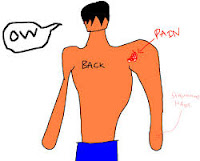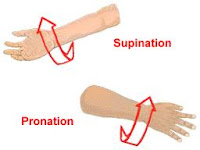A student writes:
1. How is it possible to establish the right amount of forearm weight to be used when playing, without falling into the trap of the so called "relaxation"? I mean, starting to loose fulcrums in the shoulder, elbow or other fulcrums. I very
2. When we play a key, we do it trough coordinate forearm/hand/finger motion, using the forearm weight to overcome the key's resistance. Then, we balance the weight on the bottom of the key (at the moment very hard for me to balance properly).
Then, when we want to play another key we use the rotation to transfer the weight of the forearm.
My question is: while we do a preparatory swing in order to play, let's say from a "C" with the 2nd finger, to a "D" with the 3rd finger, are we still balancing on the 2nd finger?
When is the right moment to let the weight go from the 2nd finger and swing it to the 3rd?
Try this: Practice dropping your arm into individual keys, as a unit, using one finger at a time (2-5) landing straight, upright. Stand on each finger for a few seconds and ask yourself if you feel you could stand there indefinitely—not pressing down, but not lifting up. The best analogy I can think of is that of standing upright on your feet at ease, the way I learned to do when I was in the army. The drill sergeant taught is to stand without locking the knees, crucial to being able to stand for a long period of time without fainting.
You should not experience shoulder pain from
playing the piano. Again, without looking at you I can't really diagnose accurately. However, first check the height of your bench; the elbow should be level with or slightly above the key bed. Then, try dropping your right arm down to your side and notice how the hand/arm unit feels. Raise it up from the elbow and rotate the hand toward the thumb side and place it on the keys, keeping that same, closed and at ease feeling. You should now be in a perfect position to play, with all the fulcra available. It is from this position that you should explore what it feels like to stand on one note. Remember, the hand/arm unit can be at any angle with the keyboard as long as it is straight with itself.
playing the piano. Again, without looking at you I can't really diagnose accurately. However, first check the height of your bench; the elbow should be level with or slightly above the key bed. Then, try dropping your right arm down to your side and notice how the hand/arm unit feels. Raise it up from the elbow and rotate the hand toward the thumb side and place it on the keys, keeping that same, closed and at ease feeling. You should now be in a perfect position to play, with all the fulcra available. It is from this position that you should explore what it feels like to stand on one note. Remember, the hand/arm unit can be at any angle with the keyboard as long as it is straight with itself.
when we lift a foot and attempt to propel our bodies forward, one foot leaves the floor and all weight is on the other foot. So, just as in walking, when we swing away from one note toward another note—as in C to D with 2 to 3—at the moment 3 arrives at the bottom of the key, 2 releases, thus having transferred its weight forward. Note that if a finger strikes a key but doesn't actually feel "complete," that is, doesn't really arrive at the bottom of the key even thought it sounds, the arm registers what I call a sort of bump. This is very much like what happens if we attempt to place one foot in front of the other without transferring the weight. We call this a limp and the result of continuous limping can be the involvement of other muscles trying to accommodate the lack of coordination. At the
keyboard, this limp translates as holding, or hovering above the keys and could be a source of shoulder discomfort.
So, the simple answer to your question is yes, the weight is still on the 2nd finger until its rotation is complete, and has transferred its weight to the bottom of the next note.





No comments:
Post a Comment